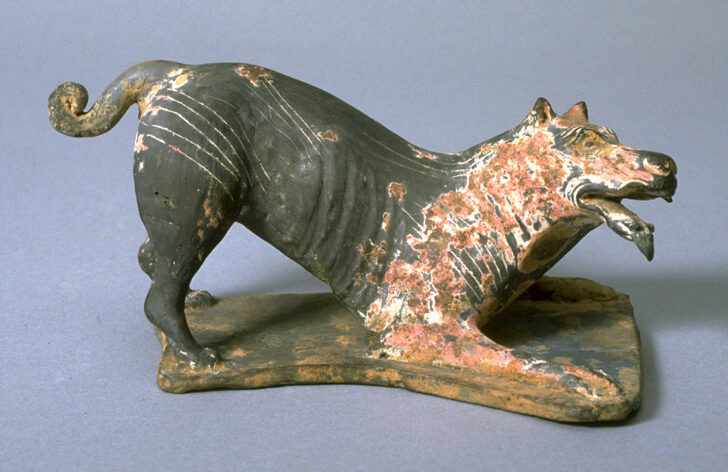Dog
Chinese

Description
This clay dog would have been buried in a tomb to accompany departed souls in the afterlife.
Subject Matter:
Since the Qin dynasty (221-206 BCE), ceramic figures have been used to replace human sacrifice in burial practices as mingqi (明器), literally "bright objects", or grave goods, as a way to provide for the deceased. Mingqi could include houses, towers, gates, granaries, livestock pens, chicken coops, wells, cooking stoves, storage vessels, dishes, incense burners, and lamps. Figures could include horses, dogs, anthropomorphic animals and people such as officials, guardians, servants and entertainers. By the Han dynasty, they also included representations of common people engaged in the activities that consumed their daily lives such a cooking. The tombs in southern provinces of Sichuan and Shaanxi have revealed a vast array of figures in playful and humorous poses. As grave goods, these mingqi included everything one would need to ensure a comfortable transition into the afterlife. The number of ceramic mingqi items in a tomb could reach numbers of a few to several hundred objects.
Along with horses, birds, and other animals, dogs are also considered to be sacrificial animals in ancient China. By the Eastern Han Dynasty ceramic sculptures of dogs had become commonplace in tombs as mingqi (明器), or grave goods for the afterlife. They were usually sculpted by hand, with close attention paid to the individualization of several different breeds.
Physical Description:
A gray earthenware sculpture of a crouching dog on a platform, resting on his two front paws, mouth open and pointed ears, long tail with curled end, with polychrome mineral pigments.
Usage Rights:
If you are interested in using an image for a publication, please visit https://umma.umich.edu/request-image/ for more information and to fill out the online Image Rights and Reproductions Request Form.